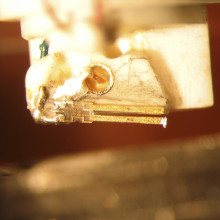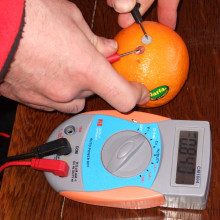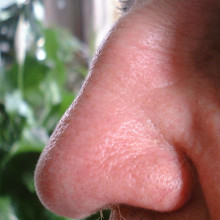This week the Naked Scientists go virtual! We'll be hearing how a new computer system can accurately gauge your age from a mugshot, we come face to face with the painting fool, a computer that can read - and then paint - your emotions, and We find out what's still lurking on your hard disc, even after you think your wiped it. We also unveil Second Naked Scientists - our home in Second Life - and get stuck into a new molecular glue designed to replaces surgical stitches and staples. Plus, in Kitchen Science, Ben and Dave embark on a far from fruitless mission to charge an MP3 player with an orange...
In this episode

Gecko Glue
US scientists have taken a leaf from the foot of a gecko to develop a self-dissolving surgical glue to replace stitches and staples. The new material consists of a layer of a polymer called PGSA, short for poly(glycerol-co-sebacate-acrylate), coated with a layer of oxidised dextran sugar molecules. The dextran layer, which sticks tightly to the PGSA, can also form chemical groups known as imines when it meets proteins such as on the surfaces of skin cells.
 |
| A Gecko foot, showing the sticky pads which are so inspiring © Shimbathesnake @ WIkipedia |
The team prepared the sticky sheets by painting the chemicals onto the surface of a silicon template, the surface of which was fashioned into a series of tiny thread-like projections resembling the hairs which are found on the foot of a Gecko. This introduced the same pattern of nanoscale pillars into the PGSA which was fixed in shape before use with a blast of UV light.
To test its sticking power the researchers fixed small 4mm discs of the material to glass slides and allowed it to glue itself to a strip of pig intestine, the end of which was fixed to a force-meter. The tension in the strip of tissue was increased until it broke free from the PGSA-glue. The experiments showed that a square centimetre of the material was surprisingly strong and could support a weight equivalent to a small book.
Next, to confirm that the material could be used safely inside the body the team implanted small discs of the material adjacent to the abdominal muscles to mimic how it might be used surgically. Tests showed that the tissue-glue bound itself tightly to the muscle and produced mimimal signs of inflammation.
Another benefit is that the material is self-dissolving, and other molecules such as growth-promoters or antibiotics can be incorporated and slowly released from the matrix to fend off infection and promote healing. The team also suggest that by varying the nano-structure and composition of the material it should be possible to produce variants of the glue with different tissue adhesive properties for different surgical jobs. The discovery, which is published in this week's PNAS, still needs to be evaluated for safety in humans, but if all goes well then it could be coming to a wound near you, soon!

Banned drug gives clues to depression treatment
Nowadays depression is often treated with drugs, but sometimes the effects of treatment can take many weeks to appear. So there's an urgent need to find drugs that act more quickly. Scientists are now turning to ketamine, a drug usually used as an anaesthetic by vets, and notorious for being abused by clubbers, as it causes hallucinations and other effects.
 Previous clinical trials have found that ketamine can help relieve depression within hours, but there are obviously significant side effects and issues with using the drug as a regular treatment. Now researchers in the US have discovered how ketamine exerts its effects on depressed patients, which could point towards new drugs with fewer dodgy effects.
Previous clinical trials have found that ketamine can help relieve depression within hours, but there are obviously significant side effects and issues with using the drug as a regular treatment. Now researchers in the US have discovered how ketamine exerts its effects on depressed patients, which could point towards new drugs with fewer dodgy effects.
Ketamine acts on proteins in the brain called NMDA receptors, blocking their action. Sungho Maeng and his team have found that the drug's speedy antidepressant effects are actually due to the activity of another receptor, the AMPA receptor. Now that we know that the biological targets of ketamine are these two receptors, and particularly the AMPA receptor, it's possible to start designing new drugs to target them effectively. But without seeing pink elephants along the way.

Molecular billiards
Scientists have revolutionised the study of chemical surfaces by coming up with a way to push individual atoms around like a miniature billiard game. Markus Ternes from IBM's Almaden Research Center in San Jose used a technique called atomic force microscopy to move atoms of cobalt over platinum or copper surfaces and at the same time measured the friction between the atoms and the surface. The technique makes use of a tiny quartz probe shaped like a miniature tuning fork. One prong is fixed whilst the other vibrates 20,000 times per second but over a very small distance. When the sharp tip of the probe is brought close to an atom of interest the electrical interaction between them alters the vibration frequency of the probe by a characteristic amount, allowing the atom to be identified. But team have also found that the atom can be moved by dragging the probe across it, and by measuring how much force needs to be applied, the friction between the atom and the surface it's sitting on can also be calculated. By measuring the behaviour of atoms sliding over a surface in a range of directions the team are able to generate "energy landscapes" which resemble the atomic equivalent of an egg-box with low-energy wells where the atoms prefers to sit on the surface; these areas represent the spaces between the atoms making up the surface. Intriguingly, a cobalt atom sitting on a player of platinum requires more than 12 times the force to move it compared with the same atom sitting on copper. The discovery of this technique, which is highly reminiscent of IBM's famous 1990 experiment in which they wrote their company initials in atoms of xenon, will help scientists to much better understand how atoms and molecules interact and spread out on surfaces. Ternes and his colleagues point out that the breakthough is a big step forward in our drive to assemble nanoscale devices because it will provide a much more powerful and quantitative way to understand how atomic and molecular structures interact.
 |  |
| The oscillating tip interacts with an atom pulling it along. Which affects the speed the tip is vibrating. | The machine itself |
 |  |
| The tiny scanning head. | A close up of the quartz tuning fork, The little white bump on the fork is the tip which does the scanning |

Gecko Glue
People have been fascinated by the ability of lizards called Geckos to chase their insect prey - not just on the ground, but up walls and even across the ceiling. Many scientists have tried to emulate their abilities, but up until now they have not managed to achieve the same level of stickiness.
 If you put two atoms very close together they will attract one another by what is called the van der waals force. This force holds materials like wax together, but normally if you push two objects together they don't stick because their surfaces are so rough that only very small areas touch. Geckos get around this by having millions of tiny hairs on their feet, hairs which branch into even tinier hairs at their ends. These hairs are flexible which means that when the Gecko pushes its feet onto the wall a large proportion of the tiny hairs are within an atoms breadth of the surface of the wall and so will stick to it. With feet like these, a Gecko can hold up about ten newtons of weight for every square centimeter of 'toe', (10N/cm2).
If you put two atoms very close together they will attract one another by what is called the van der waals force. This force holds materials like wax together, but normally if you push two objects together they don't stick because their surfaces are so rough that only very small areas touch. Geckos get around this by having millions of tiny hairs on their feet, hairs which branch into even tinier hairs at their ends. These hairs are flexible which means that when the Gecko pushes its feet onto the wall a large proportion of the tiny hairs are within an atoms breadth of the surface of the wall and so will stick to it. With feet like these, a Gecko can hold up about ten newtons of weight for every square centimeter of 'toe', (10N/cm2).
Scientists have been trying to copy this technique using carbon nanotubes, as they can be long and thin like the hairs on the Gecko's toes. So far, they've not had much success, but now, Liming Dai and colleagues at the University of Dayton have used carbon nanotubes with very flexible tangled ends. If you push them onto a material then the the tangled ends get very close to the surface, and stick through van der walls effects. If you then try to slide it off, the flexible ends of the tubes will drag across the material increasing the area of contact and therefore the stickyness.
Material made from these nanotubes is capable of supporting a force of 100N (or 10kg), but it does need to be pushed on to the wall with about 50N for every square centimeter in order to make it stick. This is far more than a real geckos foot requires and would make a spiderman suit a bit impractical.
However, it does have some other advantages - the nanotubes conduct electricity so it could be used instead of solder for making good electrical contacts, and, unlike many glues, they won't be affected by the vacuum of space.
So, for now, they will probably be more useful holding spaceships together than allowing people to climb buildings like their favourite web-slinging superhero!

The eyes have it – or do they?
For 150 years, zoology students have dutifully learned that circular markings on animals, such as the so-called eyespots found on a butterfly's or moth's wings, are there because they look like the eyes of that animal's predator.
It was thought that these "eyes" scare off anything hoping to have a quick snack. But now researchers at the University of Cambridge have made a discovery to overturn this idea.
Writing in the journal Behavioural Ecology, the researchers tested how wild birds reacted to moths made out of paper, painted with an assortment of different eyespots and pinned onto trees in woods near Cambridge. They tested spots of different shapes, sizes and number, and with different levels of similarity to the birds' eyes. Attached to each of the artificial moths was an edible mealworm as a temptation for woodland birds such as the blue tits, great tits, blackbirds, and house sparrows.
The scientists found that artificial moths with circular markings lasted no longer than those with other conspicuous marks such as bars or squares. In fact, the team discovered that the predators were most put off by large sized spots, a high number of spots, and if the spots were generally conspicuous.
The researchers conclude that, in the wild, eyespots work because they are highly conspicuous features, not because they mimic the eyes of the predators' own enemies.

Lemon-Powered iPod - Fruit batteries

Guess your Age
with Kate Smith-Miles, Deakin University in Australia
Chris - Recently there have been several news reports on the dangers that young people can face when they get onto the internet. For example, there is some content that young people shouldn't be allowed to access in the first place. Now, how can a computer actually know the age of the person who is using it? Well at the moment it can't, but that could be about to change.
Kate - I'm Kate Smith-Miles, I'm head of the school of Engineering and IT at Deakin University in Australia. We've been looking at trying to get computers to be able to guess a person's age based on their face. This is a part of machine intelligence and there are lots of obvious applications.
Chris - Is it very difficult to do that Kate 'cause, I would have thought that it's relatively easy to just build a big database of what faces look like at different ages and then compare them?
Kate - It is, the typical approach that others have taken is to have a database of faces where you know their ages and say here's a face, this is the answer, here's another face, this is the answer and get a computer model to learn the relationships. We've taken a slightly different approach and I think it's the reason we're getting better performance than the existing methods. So we're taking photos of people at different ages in their life and we're getting the computer to learn what happens to the mathematical properties of the face over time.
Chris - But surely that's rather difficult because you've got to do a lifetime of tracking of an individual to see how they are going to change over say 70 years, aren't you? So how do you squash 70 years into the few years that you've actually been working on this?
Kate - Well we're very lucky that there are some existing databases of about 600 people with maybe 5 photos each throughout their life. We've got about 3000 faces so we're able to learn for a particular person what happens to the facial features over time.
Chris - So how does the program actually get to grips with a face? How does it take a face apart and work out what bits are what and how age affects those different bits of the face?
Kate - First of all, we're working with face images that are tightly cropped, so we're not looking at hair or ears or anything like that, just the actual face region. We then have a sort of semi-manual process identifying landmark features around the face, so the corners of the eyes and the tip of the nose and the bottom of the chin. We've got 68 points around the face that we landmark and then that, of course, is a series of numbers. We then tell the computer here is a set of numbers for a certain face and this is how old the person is and we get a mathematical model to learn the relationship between those inputs and the outputs.
Chris - So in other words, how those different landmarks change relative to each other over time to then map out what changes. How do you see this being used? What sorts of applications would it have in say the workplace or on the internet?
Kate - Well one of the things that is attracting most of the attention at the moment with our work is the applications in protecting children from adult material on the internet. For instance, I've got a 5 year old daughter. I walked into the study one day and she was spinning around and asking me what our password was for an online dating agency, and I thought, 'how did she get to that?' I hit the back button on Google and she'd gone into Google and typed, 'I want a friend,' and up had popped a whole series of adult related sites. Now the webcam was on it would have been great if we'd have had some software on the computer that had of recognized that she was just a child and when a child says, 'I want a friend,' they mean a completely different thing to when an adult says it. That's one application we're having a lot of conversations at the moment with ISP's. In Australia here's been some new legislation that was introduced last month that requires ISP's to be able to verify the age of computer user prior to making access available to adult material. At the moment the way they do it is with a popup question, 'are you over 18?' So I think there are a lot of applications of improved technology in helping to protect children from these sorts of things. Then, of course, there are the applications with vending machines and cigarettes and things like that.
Chris - Well you very kindly analyzed some of the faces of us from the Naked Scientists. I've actually got them in a sealed envelope so I haven't seen these. I'm going to have a look and see what you found when you looked at our mug shots that we sent to you.
Kate - I hope we haven't insulted anybody.
Chris - Well let's find out. You reckoned for Ben: 27, so that's not far off. Chris, that's me: 30. Now that's good because I'm actually 33 so you
thought I was a little bit younger! Dave: 35. Now Dave's actually in his late twenties so how do you explain the fact that Dave has been aged by so many years? He's gained 18% more years than he really has I think.
 |  |  |  |
| Chris | Dave | Ben | Meera |
Kate - I'm not sure. I'm looking at the photo now myself. Compared to the 3000 facial images that the computer model has been trained on there's something in his face that he has some similarity with a 35 year-old. I don't know, maybe he didn't get much sleep the night before. Sorry, really not sure, we don't want to insult anybody.
Chris - Well you can be my best friend because you actually thought I was younger than I am so thank you very much for that.
Kate - Well you must get that a lot, people telling you that you look younger.
Chris - I do actually and it's really interesting that I think, 'why is that, why do people think I look younger than I am?' Do you have any insights into why some people actually do look their age and others don't?
Kate - No, I don't. I mean obviously humans have the advantage of looking at hair and body build and gesture and other things and voice as well. This computer was just looking at the face region alone but I wouldn't be at all surprised if you're constantly hearing that you look younger than you are and I don't know why. Is it skin tone? You know, there are a lot of things that our computer algorithm isn't considering as well. Humans, I should say, have a really hard time with this task. We rely very heavily on those additional factors. If you ask a human - if you give them a tightly cropped facial image and ask them to estimate how old somebody is they're not very good at it. In fact our algorithm is better than the human subjects we tested. So we can predict the age with our computer algorithm to within about 4 years for adults and 1 year for children, and humans the error is usually more like 6 years for adults.
Chris - So how long will it be before I can buy this and have this installed on my computer to stop my daughter finding a friend that she shouldn't find online?
Kate - I'd say we're a couple of years off having a commercial product. There's a number of challenges that we still face, first of which is of course even identifying where the face is in the webcam shot and then there's the landmarking process identifying all the facial features is a semi automated process, but we need to fully automate that. There's a number of challenges we're working towards at the moment.
Chris - I particularly like the way Dave turned out to be age 35.
Kat - Ha, I think it's the beard actually.
Chris - Dave hasn't got a beard.
Kat - Well he's a bit beardy.
Chris - Do you think it's the stubble?
Kat - Yeah. You're a baby face anyway.
Chris - You're very polite. Anyway, that was Professor Kate Smith-Miles. She's at Australia's Deakin University where she's developing a system to enable a computer to work out the age of the user based on what they look like.

The Painting Fool
with Simon Colton, Michel Valstar and Maja Pantic
Meera - The emotionally aware Painting Fool, sounds exciting, but what does it do? Well that's the name of the winning machine from the 2007 Machine Intelligence Awards. It's an artificial intelligence system that's made up of two pieces of software. The first is an emotion detecting system that videos your face and analyses it to see what emotion you're feeling. The second part produces and abstract painting of you on the screen using colours and styles to reflect the emotion that it think you're feeling. These combine to produce a system that could revolutionise the art world either by giving artists some competition or helping them to design their masterpieces. I met up with the creators Simon Colton, Michel Valstar and Maja Pantic this week to find out more and also to see what emotions the machine thought I was feeling. I spoke to Maya first about how the emotionally aware Painting Fool works.
Maja - It is a system which is combined of two systems: one is the visual part to the system and the other is the painting part. The visual part detects automatically the emotion of the sitter from live video while the painting part of the system uses this information in order to choose the paint and then highlights this emotion in the painting of the sitter.
Meera - When you say sitter, you just mean the person standing in front of the video?
Maja - Exactly.
Meera - So you've already set up the equipment ready for me to have a go. I'm just going to go and stand in front of it and portray my emotions.They've taken a video clip of me looking neutral and then smiling afterwards and now the first part of the machine is processing it. What's going on Michel?
Michel - At this point it has found in the first frame where exactly your face is and next it will find 20 facial points such as the points on your eyebrows, the corners of your mouth and the corners of your eyes.
Meera - It's saying I'm very happy. How's it found that out?Michel: Basically we tracked those 20 points through the image sequence and based on the distances between the points and the positions of the points and the speeds of those points we found out which facial muscles you were using.
Meera - So once you know the facial muscles in use, how does this then translate to it knowing the emotion, Maja?
Maja - We are trying to detect six basic emotions which are: surprise, fear,sadness, happiness, anger and disgust. For each of these emotions there are certain facial muscles which are activated. For surprise your eyebrows are raised and your eyes are wide open and your mouth is wide open. So based on these kind of rules we are able to recognize which emotion is shown in animage and in this case as can be expected the smile triggered actually happiness. This point as you see the painting will start its work.
Meera - Ok yeah, so it has started painting me now. Simon, how has itstarted producing this painting?
Simon - Well it's been given three important bits of information from the vision software. It's been given the emotion, happiness. It's been told where the eyes, nose and mouth are and it's been told which picture within the video sequence where you're expressing your emotion the best, where were you smiling the most. First of all it's going to paint that picture.It's going to spend more detail on your eyes, nose and mouth so it makes itl ook more like you and it's going to choose its painting style according to the happiness emotion. It's turned your face into a number of regions of colour then for each paint region it chooses the colour for that paint region. It chooses whether to enlarge or make it smaller. It can do that with the eyes for example to emphasize the emotion in the eyes and it chooses how to simulate the painting in of that paint region.
Meera - If someone else was to have stood in front of that camera, would these colours still have come up?Simon: I've trained it specifically to use a colour palette of about 15colours, all of which are bright, and it does use different ones depending on the facial colours of the person using it. The bigger difference would have been had you not smiled and had you shown fear, or had you shown disgust, it would have produced a completely different picture. It would have stretched your face, it would have painted you in greys and kind of rotten tones and it would have used a very loose painting style so that it would really emphasise the distortion of the face.
Meera - How have you given it the information so that it knows how to appreciate its subject?
Simon - I trained it like a human painter would train an apprentice so I've told it, for example, that if it uses greens and reds then that's likely to heighten the anger in a picture. I've told it that if it uses a stretched face then certain people will associate that with Edvard Munch's The Scream: that famous painting where there is disgust going on. What I'm aiming for more with this is to get the software accepted as a creative artist in its own right, independent of me as the software originator. The next thing I wanted to do is to imagine completely new scenes and paint from its imagination.
Meera - You have obviously combined together for this project and created the emotionally aware Painting Fool. Where do you want to continue this merger, Michel?
Michel - Well what I think we want to do is make it even more aware of its subject matter. There is so much more information in the face that we could use. For instance, gender: we could paint it differently depending on whether it's a man or a woman. But also maybe age category and even we might look into beauty aspects of the face.
Meera - My painting is now finished and considering how abstract it is, itr eally does look like me I think but also you can tell that's a girl. How will you make it distinguish between males and females even more?
Michel - Well of course it looks like you because it's based on your portrait, your image, and therefore it will always resemble a girl. We could actually enhance the feeling that you get when you look at a painting if we know what the actual gender of the sitter was.
 |  |  |
 |  |  |
| Anger | Disgust | Fear |
 |  |  |
 |  |  |
| Sadness | Surprise | Happiness |

Second Life
with Gordon Clarke from NPL and Dave Taylor from Imperial College
 |
| A beach party in Second Life, location: T Online Beach (115,40,21) © Dimelin |
Chris - Some people say, 'why don't you go and get a first life before you worry about your second life.' But in fact, Second Life is a phenomenon on the internet where there's a whole virtual world. We've got two pioneers who've done some great stuff in terms of what's happening with the science that you'd find in Second Life with us today and that's Gordon Clarke. He's a researcher and he's based in the National Physical Laboratory and also Dave Taylor from Imperial College, London. Let's kick off first of all with Dave. So Dave, what actually is Second Life?
Dave - Second Life is a 3-dimensional virtual world made of islands which can either be standalone or joined together on two continents. Much of Second Life is to do with social things and entertainment but there is a serious side and a lot of scientists and technologists in Second Life meet, collaborate, attend meetings or discussions.
Chris - How does it work? What's the interface, how do you get into Second Life?
Dave - You have to run the specialised browser which you can download from Secondlife.com or from science.org.
Chris - That's free.
Dave - It's free, yes that's right but you can't use a web browser. That, basically, gives you a view into this virtual world which is about 15 times the size of Manhattan so there's a lot there.
Chris - Wow, that is quite large. So if someone were to appear there what would they see? How would they be incarnated in this second life?
Dave - You have a great deal of choice about what you look like. You get to choose if you're male or female. You get to choose what your clothing is, your hair colour - everything like that. It's totally customisable. It's up to you what you look like.
Chris - This could be quite good for people who don't really want to look the way they do if they feel a bit intimidated interacting with people in real life then they can have all the interactions. You can presumably talk and send messages to people in Second Life but you don't have to like yourself, basically.
Dave - Yeah, that's right. I think there's two groups really: people who like to look a little bit like themselves and people who want to look completely different to themselves.
Chris - What do you look like?
Dave - I look kinda similar to myself.
Gordon - So do I!
Dave - ...but quite a bit younger, I think.
Gordon - Umm, about right.
Chris - So would you fool
Kate Smith-Miles' software that we were talking about earlier with your avatar? When you're wondering around in Second Life you're wondering round as you see yourself as a person in there?
Dave - That's right and of course other people. Immediately you get person-to-person interaction which you don't normally get when you're staring into a computer screen.
Chris - What about if you want to converse with someone? We're having a chat, we've got eye contact so if I was in Second Life as a person I'd see myself and say, Dr Kat here and you guys. I could see you there and if we wanted to talk what would happen?
Dave - You can type and some people are a little bit too shy to speak so they're quite happy typing. You can give private messages to one-another as well. As you type the words come up above your head or you can speak.
Chris - Real speech?
Dave - Absolutely, it's like Skype on steroids.
Chris - Why do you say that?
 Dave - Because it's three-dimensional sound. So if somebody's in the left you hear them on the left. If they walk towards you they get louder. Unlike the real world, you can actually move your point of view and your ear goes with your eye, as it were, so you can listen to the group in the corner.
Dave - Because it's three-dimensional sound. So if somebody's in the left you hear them on the left. If they walk towards you they get louder. Unlike the real world, you can actually move your point of view and your ear goes with your eye, as it were, so you can listen to the group in the corner.
Chris - Let's look at the sort of science that's going on there because this sounds like an amazing tool to do science with as well. What sorts of projects are going on at the moment to get the message about science across?
Gordon - I think you have to remember that when you go in the world, when you go into Second Life, everything you see has been created by one of the other Avatars. It's the users that create everything. If you want to do something scientific you take your design or experiment or whatever it is and you go in the world and you build it. You can build anything from - there's a Mars impact simulator, which is brilliant because you have this asteroid that comes down out of the sky and hits the ground in front of you. There's big flames that fly everywhere and a big crater forms.
Dave - You can go on a ride to the planet.
Chris - Who hosts you? Is that Richard Branson and Virgin or is it existing characters?
Gordon -
Chris - Who takes you to the planets then?
Dave - The International Space Flights Museum has got this ride to the planets. It's a Gemini rocket. You just hop in and you launch yourself.
Chris - How realistic is this? Is it (a) scientifically realistic and reasonable - you're not bending scientific rules to do this; and is it also [b] a valid educational experience - people learn something by doing this?
Dave - Absolutely yes. The trip to the planets takes you past the International Space Station, you can have a look at the space shuttle. You can visit the planets; you can even visit the surface of Mars and see some of the vehicles that have landed there.
 |
| Second Health Hospital © NPL |
Gordon - Last week I took a trip round a testicle.
Chris - What?!
Gordon - Well, quite! I'm not going to repeat that again but it was looking at spermatogenesis: the formation of sperm within the testicle.
Chris - So you it's a big, blown up version?
Gordon - Yes. It's absolutely huge.
Chris - It's almost like walking through the body in the Millennium Dome?
Gordon - You're sat in a little flying car that guides you through the various ducts.
Chris - So they could be very good for learning anatomy if you're a medical student.
Gordon - Yeah, it was very accurate.
Chris - How do you see this being extended? One of the reasons you're here today is because you phoned me a while back to say, look, you think there could be some possibility for the Naked Scientists getting involved with this. We actually did start talking. We've done some stuff. Tell me a little bit about what you have in mind for this.
Dave - Well, it's great fun attending meetings in second life with other people. There's a lot of repartee in the audience. A lot of people will help to explain things to other people so actually listening to a radio show together is a great activity to do in Second Life. We thought you could do with a studio audience and you can have one in Second Life.
Chris - Take us on a virtual radio tour of what you've set up for the Naked Scientists, Gordon.
Gordon - Well, we're part of a group of islands called the Scilands. Right in the centre of the Scilands we have built you a radio theatre. It's rather a fetching building with a radio mast sticking out of it and the name 'Naked Scientists' rotating in bright purple at the moment above it. People can listen to test transmissions. I'd just like to say hi to Troy and all the other people listening out there.
 Dave - Hi Troy.
Dave - Hi Troy.
Gordon - People can just sit, relax and listen to the radio show. There's a lot of chatter that goes on during the radio show.
Chris - You get the Naked Scientists radio show which is live. We're piping it out of here and straight into there. So people who go there can hear it running but they're also able to talk to each other while the show's on: a sort of mini-discussion. It's a bit like Oprah Winfrey but on the Naked Scientists, isn't it?
Gordon - Yeah. I went to another radio show last week and ended up having quite an involved discussion on the philosophy of science.
Dave - The interesting thing is that a lot can come out of different disciplines meeting and having corridor discussions. Where there aren't corridors in the real world. We've built these corridors in Second Life. For example, two organisations that normally wouldn't have got together - the University of Denver and the national Physical Laboratory - we decided we should build a nuclear reactor in Second Life. That's a project that's now off the ground that's an Anglo-American collaboration.
Chris - When you say, 'build a nuclear reactor,' this presumably models a nuclear reactor so people can go in there, see what it looks like and see how it works.
 Dave - Yes, we're modelling a specific scientific experiment so again students don't have to be exposed to radiation. They can do the experiments in safety.
Dave - Yes, we're modelling a specific scientific experiment so again students don't have to be exposed to radiation. They can do the experiments in safety.
Chris - It's the x-ray radiation from their computer screen!
Dave - In an LCD, maybe not.
Chris - Brilliant, well if people want to listen to the Naked Scientists in Second Life every Sunday how would they do that?
Gordon - As Dave said they would have to download the browser and register their own avatar. They need to search for Scilands.
Dave - Even easier, if they actually register at
Scilands.org and download from there then they will appear in the middle of the Scilands, right next to where your show will be broadcast. They have a ten-minute orientation so they find out how to move around as an avatar, how to speak to people, how to listen and so on.

38:47 - Data Recovery
Data Recovery
with Graham Henley from Getdata.com
Ben - Many of us rely on using computers to store an awful lot of vitally important information and there's nothing like the heart-sinking feeling when you've deleted the wrong file or even worse you turn on the computer to be greeted by an error message saying, 'no bootable partition,' meaning your hard drive is completely dead.
There may be a way you can get back that data, even the things that you thought you'd deleted on purpose. On the line with me now is Graham Henley from
Getdata.com. So Graham, firstly how is data actually stored on a hard disk?
Graham - A hard drive is a magnetic medium so as we all know it's stored as 1s and 0s on the drive. When a file gets stored on a computer essentially there's a table at the start of the hard disk. The table tells the operating system, Windows, whereabouts that file is stored on the disk. When you press the delete button or in fact format your drive what you're doing is going to that table at the start of the disk and telling the computer that that particular reference, that file in that table is no longer there. It doesn't go out to the disk itself, find the data and overwrite it.
Ben - Although Windows no longer knows where to look if you were to actually look through the hard disk itself you'd be able to find all the files you thought you'd formatted away?
Graham - Yeah that's right. It's essentially like going to the index of a book and then taking a pen and then scrubbing out the index entries. The page with the content is still out there in the middle of the book. It's just that the book no longer knows how to find it. You can imagine that all that data is still out there on the disk and can be recovered.
Ben - So what about when it seems that your hard drive has died? Even if the actual contents effectively are still there and you've still got the index file at the beginning of it, if you can't get your hard drive to work the surely you can't get to that data?
Graham - There's two types of data recovery. If you have a physical problem with your hard drive, and hard drives do physically fail, they wear out, bits get old and worn down then your only hope to get data back is to send it to a hardware recovery service. Probably 60 or 70% of the time the problems with having lost data or deleted files is usually what we call a logical problem. That means that the drive is physically functioning okay, it's just that the logic of how the files are found or where the files are on the disk is a bit screwed up.
Ben - So how do you go about getting back the data that we think we've deleted?
Graham - Well, our program Recover My Files goes out to the drive and does three levels of search. The first type of search it can do is look for a partition. Now partition is a fancy word for what we describe as the C: drive, D: drive or the E: drive. What it's trying to find is that big index full of files. It finds that index, it interprets it and displays all the files. The next step down from that is every single file in that computer at the start of the table has an entry. That entry tells the computer the name of the file and the storage sectors on the disk where that file resides. In many cases all that information has been destroyed. You might have somehow overwritten that first part of your disk and corrupted all of that information. The very lowest level of search that Recover My Files does is it goes across the drive. It tries to fin individual files on the drive by their header and their footer. Every Microsoft Word document starts in a particular way. At the start of the file there's certain characters that can easily be identified. We identify the start of the file, we look for the structure of the file and then we identify the footer of the file. We can still bring that out and display it as a file. You can still see pictures, documents and other sorts of files.
Ben - Doesn't this mean that if you sell off your old computer or your old hard drive then people can use this software, such as identity thieves could you use it and actually get back your files, which may contain your bank details or your passport information, that sort of thing?
 Graham - If you're ever in the situation where you want to give away a hard drive it's very important that you wipe a hard drive clean. When you delete a file it's recoverable and it'll stay on your drive. It will only stay on there up until such time as it's overwritten by something else. You need to deliberately go out and wipe that hard drive clean. The wiping programs that are available, they go out and they start at the beginning of the drive and write 0s all the way across the drive, right to the very end. That's what's meant by wiping a drive. If you just format your drives when you're giving them away that doesn't do it. All your data is still in the drive. It's a real security risk.
Graham - If you're ever in the situation where you want to give away a hard drive it's very important that you wipe a hard drive clean. When you delete a file it's recoverable and it'll stay on your drive. It will only stay on there up until such time as it's overwritten by something else. You need to deliberately go out and wipe that hard drive clean. The wiping programs that are available, they go out and they start at the beginning of the drive and write 0s all the way across the drive, right to the very end. That's what's meant by wiping a drive. If you just format your drives when you're giving them away that doesn't do it. All your data is still in the drive. It's a real security risk.
Ben - I understand that you used to work with the police doing their data recovery from seized computers. Did you just use the same techniques there or do you have to go a bit more forensic when looking for evidence of a crime?
Graham - Myself and one of my colleagues were in the Australian Federal Police in Australia. We worked in the Computer Crime section and we were obviously very involved in high profile and complex investigations involving computer evidence. Really, the way our company got started is that we were having to write our own applications in order to go out and interpret data on the hard drive and to recover deleted files.
Ben - Are criminals savvy enough with computers to make sure they do actually wipe their data?
Graham - I've examined drives and found they've employed a wiping tool. In one particular case we could see that the person had overwritten the data before we'd arrived and I could see in the storage sectors the words, 'sucked in,' all the way across the drive. They'd deliberately gone out and wiped it clean and left a message there for us.
Ben - So criminals are obviously paying attention, they know how to wipe their drives. What about government institutions and so on? Could you goout, buy a load of second-hand hard drives and get some really juicy data out of that?
Graham - It's an interesting exercise to go to a second-hand computer market, pick up some hard drives and run Recover My Files. It's just incredible what you can bring back. It's not just the files that are on there. If you imagine when you're surfing the web all your web pages are being brought down and stored on your computer. If you do web banking, for example, you can see balances and transactions etcetera in those web pages.
Ben - I guess the moral of this is don't panic if you did delete something you didn't intend to but do make sure you wipe your hard drive completely clean before selling it on.
Graham - Absolutely, the information that can be contained on a hard drive about someone's life is incredible so if you're ever selling your harddrive on then you definitely should wipe it.

45:55 - Size of Smell Sense?
Size of Smell Sense?
Greg Jefferies, Medical Research Council Laboratory of Molecular Biology:
The simple answer to that is yes and I'll try and explain a little bit about why that is.
So if you're thinking about some signal in the outside world, there are two steps probably that you could divide the process up into. The first is actually taking the signal and turning it into an electrical signal inside your body and the second is the brain then processing it and telling you about it. So we'll call the second step perception and we'll assume that you're really interested in this signal. What's going to determine how sensitive to the signal you are is really this detection step, this sensory detection step. What you have are specialised detectors at the top of the nose. These are protein detectors and the way they actually signal a smell is that a smell consists of odour molecules diffusing about in the air. They come up to the top of the nose and bind to these protein receptors. Now they don't just bind to any oldreceptor. There's sort of a lock and key fit between the smelly molecule and the receptor. So if you don't have receptors which can fit with a particular molecule then you won't smell it. Now over time, evolutionary time that is, we've acquired receptors that fit very well with odour molecules that we might be interested in. One example of a smell that we're very sensitive to it is mercaptan that's put in natural gas, so that we can detect a gas leak. It takes only one part per billion, even less than that, for us to actually detect that smell. So, to put that in another context, that's more or less the same as three drops of smell in the volume the size of an Olympic swimming pool, and we could detect that. Of course there are plenty of other odours to which we're much less sensitive. So the questioner is quite right that there are some smells which we are very sensitive to.
If I get sunburnt easily will I get skin cancer easily too?
Yes, you are. People who do burn and freckle more easily in the sun are more likely to get skin cancer. It's very important that the fairer you are, the more likely you burn, the more you should take care in the sun. Definitely. So avoid the sun, cover up and slap on the factor 30.










Comments
Add a comment